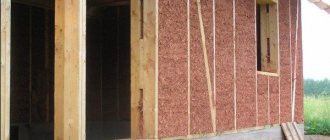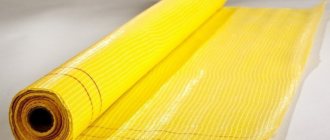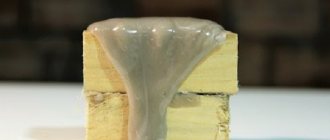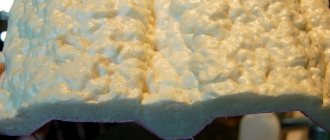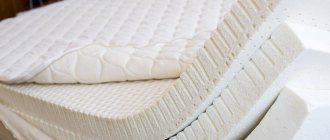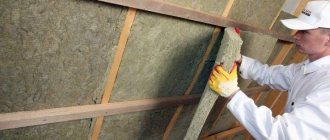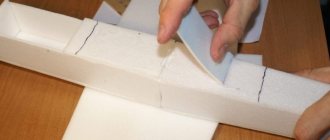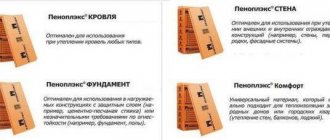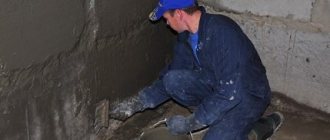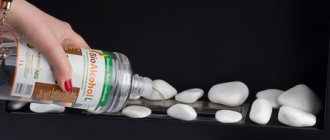Manufacturers assign different names to products - fireproof, fire-resistant, fire-resistant, fire-resistant foam. But all these names mean one thing - the foam contains fire retardants, which provide the material with fire protection. Numerous tests and experiments when exposed to a gas burner show that fire-resistant polyurethane foam does not melt, does not smolder or burn. When directly exposed to a fire source, it may become covered with a black crust on the surface, but no changes occur inside the foam for a long time.
Performance characteristics
It is important to understand that fire resistance does not mean the complete impossibility of fire. The sealant resists fire for a certain time, but will catch fire if exposed for a long time. The resistance period is different for all manufacturers, which affects the performance characteristics of the compositions.
Additional properties:
- In the high temperature range from -60 to +100 degrees, the beneficial properties of polyurethane foam are fully preserved.
- Absolutely inert to moisture, fungus and mold formation, which are not retained by the hardened sealant.
- It has increased strength characteristics compared to conventional foam.
- When heated, it does not melt, does not drip, and has pronounced self-extinguishing properties.
The only drawback is the inability to withstand sunlight, since ultraviolet rays destroy the sealant and its properties. To protect the insulation, the foam is treated with cement mortar or putty, and in some cases painted.
Fire-resistant foam is presented on the market in several types, which differ in component composition, performance properties and time of resistance to an open flame. Fire-resistant polyurethane foam is classified depending on its purpose and description of its properties and fire resistance characteristics. Manufacturers produce sealants using their own technologies, adding various components to the compositions in unequal proportions, therefore fire-resistant sealants have different properties:
- According to seasonality – all-season and winter.
- In terms of composition - one-component and two-component.
- Depending on the area of use, the sealant can be either household or professional construction.
It is necessary to follow the manufacturer's recommendations for applying assembly joints and work with sealant in the specified temperature range. The type of composition is selected depending on the purpose of using the insulation for passages of various traffic areas. The fire hazard category of buildings, equipment, and communication channels is taken into account.
Fire resistance classes
In accordance with fire safety protocols, fire-resistant building materials are recommended in areas where people may congregate.
To determine the level of fire protection, fire-resistant polyurethane foam is assigned various heat resistance classes:
- B1 – class with the highest degree of resistance to open fire. The building mass of category B1 is not subject to combustion, does not emit acrid smoke, and extinguishes on its own when the source of ignition is eliminated. Withstands heat for 2–3 hours.
- B2 – medium fire resistance class. When heated, a small amount of toxic substance is released. When the open flame is eliminated, the foam goes out on its own. With prolonged thermal exposure it begins to melt.
- B3 - although it has fire-resistant properties, compared to previous classes it is a low-melting composition. When heated, it begins to emit toxic smoke. According to fire resistance standards, it cannot be used in public places and children's institutions.
In addition to the class, the non-flammable polyurethane foam on the cylinder is marked. The values of the numbers EI 30, 60, 90, 120 indicate the number of minutes of fire resistance of the material in rooms of up to 300 people.
Where is polyurethane foam used?
Fire-resistant foam is used in the installation of fire-resistant windows and doors, installation hatches. The professional composition is often used to treat fireplaces and stoves, insulate rooms with high temperatures, and to reduce the fire hazard of saunas and baths.
Places of application:
- cracks and formations that are filled during installation or construction;
- places requiring heat or sound insulation;
- filling gaps formed as a result of laying floor slabs;
- during the construction of a chimney, heating pipes, for closing holes.
Polyurethane foam from different manufacturers differs in terms of cost-effectiveness of use. It hardens quickly and fills empty spaces perfectly. The professional one does not burn, which confirms the quality and safety of use in rooms with unstable temperatures.
Filling holes
The level of quality and fire resistance is determined by classes. The production of sealant is controlled by state standards. In the hardened state it has the density of concrete and belongs to class B1.
Fireproof fireproof foam: technical characteristics, application of fireproof foam
Mounting fire-resistant fire-resistant foam belongs to sealants and fire protection products. It is used if a certain level of fire protection is required, because if the main building materials are resistant, then the auxiliary means must meet the same requirements.
Fire-resistant polyurethane foam - what is it?
Non-flammable foam is a modification of sealants for installation and insulation work on objects with a high fire hazard. The substance is used to fill holes near wiring, doors, frames and large spaces, for example, gaps between pipes, walls, in gaps, near the chimney.
Components:
- catalysts, foam generators - determine consumption, expansion rate, solidification rate, pore size, density;
- stabilizers – give consistency uniformity;
- for fire resistance:
- flame retardants (usually mineral);
graphite, similar substances;
- main ingredient: liquid polyurethane foam;
- expelling gases.
How foam works
Fire-resistant foam is a common sealant with a similar effect, but with fire resistance, creates an effective barrier to the spread of fire, and insulates the object from flame and air.
The operating principle is standard, but with a fire barrier (GOST 30247.0-94):
- when sprayed, it increases 2 times;
- hardens, creates a high degree of adhesion;
- the polymerization process is initiated by internal chemical reactions or exposure to moisture.
Functions:
- sealing;
- fixation;
- fire protection;
- additionally:
- noise insulation (41 dB);
suitable for insulation;
- protection from moisture.
Even at maximum heating, the material does not lose its shape - objects remain securely fixed and protected from the flame.
Properties:
- good adhesion to surfaces: can be applied to plaster, brick. Low adhesion to polyethylene, glass, plastic;
- ease of use: direct the nozzle, press the gun, cylinder button;
- easy to cut, remove excess;
- penetrates deeply into hard-to-reach cavities;
- expanding when solidifying, it fixes the object;
- resistance to moisture, mold, biological and climatic threats;
- excellent efficiency - output from a standard cylinder (750 ml) is 42 - 65 l;
- does not crack.
Fire resistance of polyurethane foam
The ability to withstand fire and create conditions for extinction is the main parameter. There are several levels of sustainability.
| Parameter | Description |
| Under open fire | |
| Fire resistance limit | Up to EI360 – without loss of barrier ability, withstands temperatures and heat from direct fire up to +1000 °C for 360 minutes. Common levels:
|
What color is the foam
In order to prevent confusion, manufacturers add dyes to fire-fighting installation compounds. The main colors of fire-fighting foam are red, light cherry, brown. Most often, the shade has a high degree of brightness.
Properties retention period
As a rule, after application and hardening, the foam requires protection with plaster or paint, as indicated in the instructions, since it is gradually destroyed under the influence of ultraviolet radiation (sun rays).
Preservation of qualities:
- unprotected layer on a treated object under the influence of ultraviolet radiation (sunlight): the destruction process begins relatively quickly, after 1 - 2 maximum 4 years;
- if there is protection: the validity period of a coating protected from ultraviolet radiation (paint, slabs) or resistant to it reaches 15, maximum 30 years.
Application area
Works and purposes for which it is used:
- all construction, repair work, sealing, fixing with fire protection, and especially:
- sealing openings and holes when laying engineering systems and cables. Direct purpose: for sealing cable penetrations, similar hidden work (cavities near sockets, switches, pipes);
installation of ceilings, partitions, fire doors;
- with other fire protection (plaster, windings, slabs, plastic couplings);
- plastic and metal pipelines;
- recommendations found in SNiP:
- processing, sealing of seam segments, joints near stoves, fireplaces, heating;
for gaps between frames with high airbag requirements;
- for baths, saunas;
- any work that requires fire protection plus insulation: roofing, attics, attics;
- foam that provides acoustic and thermal insulation is used for engine compartments and cabins;
- for normal installation: in any case, it is better to take a material that, for example, has a small fire resistance rating of EI 60 than the standard one.
How to distinguish fireproof polyurethane foam from regular foam
The can always indicates its fire-fighting properties. Marking with letters EI and numbers. Often the container has an image of fire (schematic, artistic) and the words FIRE. If the graphic symbols are difficult to make out, then you need to release a little foam.
- The standard mounting mixture is white, yellow.
- Fireproof - reddish, pink, less often brown. The hardened piece does not melt or smolder.
Types and Types of Fire Retardant Foam
There are several types of fire retardant installation products. The composition must have a certificate of compliance with the air safety standards. Separation factors: ingredients, duration of flame resistance.
| Parameter | Description |
| Number of components |
|
| Fire resistance | From EI30 to EI 360. |
| Special properties |
|
To assign fire protection status to polyurethane foam, it must have at least fire resistance class B1 (difficult to combust), flammability group - G1 (does not burn on its own). There is no division into seasonal types, since it is designed for high temperatures.
Fireproof foam manufacturers
- Hilti is a brand from Liechtenstein with its own research center, known for its exemplary 2-component CP660 and 1-component CF-JI. The products are expensive, of excellent quality. Download certificate Hilti CP 660.pdf (1.06 Mb) (downloads: 136)
- NULLifire is an American company that produces inexpensive, mainly 1-component mixtures of the FF line (197, 177), Flame Shield NBS. Download certificate NULLifire FF197.pdf (1.59 Mb) (downloads: 65)
- Soudafoam – Belgian manufacturer, European quality. Under the Soudal brand it produces 1 and 2 component products: Fr, Comfort, Fr CLICK and FIX. High price segment, fire resistance record holder (EI360). Download certificate Soudal Soudafoam.pdf (3.03 Mb) (downloads: 61)
- Makroflex is a Finnish manufacturer. Spray cans with a characteristic green color are expensive. The range of fire-fighting mixtures is minimal: one PRO FR77.
- Tytan (Selena Group) – fire-resistant installation product is represented by 1-component Professional B1. Proven product at an average price. Download certificate Tytan Professional B1.pdf (834.91 Kb) (downloads: 82)
- Penosil (Krimelte) is an Estonian brand. Familiar with 1-piece, expanding Fire Rated Gunfoam B1. A kind of standard in the low-price segment.
- DKC – AF FOAM RM, AF GRAFHIT FOAM (one and two components). High-quality compositions, appropriate price.
- Fome - produces fire-resistant building mixture PRO Premium Fire Block Gun Foam and PRO FIRE BLOCK Mounting Foam with a limit of 240 min. Swiss reliability at average prices.
- Remontix – the range consists of PRO 65 FIRE STOP. Low cost, good quality, judging by reviews.
Preparation for use and use
The standard volume of the can is 750 - 850 ml. There are two options:
- pistol cylinders (Gunfoam);
- containers with a plastic spout or straw.
ATTENTION! If the document is not displayed, re-upload the file or download from the link below! Usage algorithm:
- Place in warm water - the mixture inside will liquefy, which will improve the release process. In the cold, the polyurethane mass thickens.
- Shake vigorously (30 seconds): the mixture should be well mixed.
- A tube is placed on the cylinder or the container is placed in a gun (professional products).
- The surface is cleaned of dust, dirt, and degreased. For 1-component mixtures, it must be moistened with water, it is advisable to then moisten the splints (rollers).
- Apply to the surface. The bottle is turned upside down.
- Drying process - the composition will harden in a few minutes, but will be finally ready in 6 - 24 hours.
- The excess is cut off.
- If the sealant requires protection from ultraviolet radiation, then it is covered with plaster, paint, and covered with slabs (plasterboard).
Sealing of holes and other work are carried out taking into account:
- with rapid extrusion, the material slowly expands, but penetrates deeper into small cavities (better for penetrations), and vice versa;
- The fire resistance of some brands depends on the size of the seam. Often the instructions contain tables with values, maximum penetration sizes;
- Expansion should be taken into account when applying:
- primary – immediately upon exit, on average 2 times;
secondary - the indicator is indicated by the manufacturer (25 or 30% usually). Incorrect calculation can result in deformation of the object (after 6 - 18 hours). There is less risk if there is space for the mass to squeeze out on its own - the excess part is cut off;
Wash off hands and surfaces with special cleaners; improvised means are also used for the body: soda, salt solution, “Dimexide”;
Approximate temperature conditions (options from several instructions):
- storage, transportation: -10 / +25, but up to +50 °C;
- applications: 0 / +40, -5 / +35, +10 / +30 °C;
- cylinder when using: +18 / +25, +5 / +30 °C;
- operation: -30 / +100, -60 / +90 °C;
- triggering – depending on EI;
- optimal for hardening:
- +18 / +35, less often -12 / +35 °C. The higher the temperature, the slower;
humidity up to 65%;
- The hardened fire-resistant coating does not react to temperature changes.
Rules for storing fire retardant foam
The heat-resistant mixture in a cylinder is stored for an average of 6 months, 1 - 1.5 years. Sometimes sellers specifically write that the products are “fresh”. After manufacturing, chemical processes begin to occur inside the cylinder. The fire-resistant composition begins to thicken and become viscous.
There are two options for the behavior of an expired product (in all cases, the guarantee for the result is lost):
- use is possible, but difficult;
- due to its thickness, the foam will not be able to come out and create the desired consistency.
It is recommended to keep the cans at low temperatures (the mixture is not affected by cold).
The composition becomes viscous, so before use it must be kept warm and shaken well.
Source: https://proffidom.ru/111-pena-montazhnaya-ognestojkaya-protivopozharnaya.html
Foam selection by area of use
If you need professional fire-resistant foam, then you should pay attention to RUSH FIRESTOP FLEX 65. It is suitable for structures that are subject to increased fire resistance requirements during operation. You can use SOUDAFOAM FR to seal voids
This foam can be used for:
You can use SOUDAFOAM FR to seal voids. This foam can be used for:
- protection of window units;
- between floors and ceilings;
- to fill voids.
This composition is universal, because it can be used where fire resistance is required. Using SOUDAFOAM FR CLICK & FIX foam, you can provide not only fire protection, but also form a layer that will have different sound and heat insulation abilities. NULLifire FF 197, which is a one-component product used in tandem with most building surfaces, has excellent adhesive properties.
Heat-resistant chimney foam
It is much more convenient to repair brick stoves and fireplaces using modern construction chemicals. Moreover, various sealing compounds are used during the construction or installation of chimneys.
The essence of the problem: from a wide range of products, the homeowner needs to choose a heat-resistant sealant that can withstand extreme operating conditions inside the stove masonry, chimney pipe, and so on.
Our publication will help you make the right choice.
Let's outline the scope of application
Construction supermarkets sell many sealing pastes used in heating, plumbing and sewerage systems. It must be understood that ordinary food and sanitary compounds do not belong to the high-temperature category, although they are used for the installation of some elements of chimney pipes.
Deep cracks can be covered with mortar, but it is better to fill them with sealing material
Water- and heat-resistant sealants are used for the manufacture, laying and repair of various furnaces for the following purposes:
- Sealing cracks and holes in the walls of a combustion chamber built of brick or welded metal.
- Sealing chimney pipes during repair or installation.
- Exterior finishing of brick fireplaces and stoves.
- Bonding heat-resistant gaskets (asbestos and graphite-asbestos cords) to metal fittings - doors, valves, iron ovens and cast iron stoves.
- Waterproofing of roof junctions with chimneys made of metal and brick.
Note. Some repair compounds are even used to restore refractory masonry made of fireclay bricks. One condition: the maximum temperature in the firebox is 1500 °C.
A crack in the stove masonry or welded joint of the steel parts of the firebox causes smoke in the heated room and the formation of soot in the defect area. The traditional way to eliminate it is to move the stove or cover the through gap with clay. Modern high-temperature sealant allows you to solve the problem much faster and more efficiently.
A cracked brick chimney has to be rebuilt
The suction of street air into the chimney pipe is a very unpleasant phenomenon.
More condensation and soot fall on the walls, which can ignite at any time due to the high temperature of the flue gases. Hence the need arises to seal the connections of the chimney pipe elements.
We will describe in detail about other methods of use as we review specific formulations.
Types of high temperature sealants
Depending on the nature of the defect and the location of sealing, compositions for furnaces are divided into the following types:
- silicate heat-resistant sealants that can withstand temperatures up to +1500 °C without destruction;
- silicone-based pastes with a maximum temperature threshold of +250 °C (short-term - up to 350 °C);
- special glues and mastics designed for heating up to 1000 °C;
- adhesive mixtures for external cladding of heating stoves and fireplaces with tiles, heat resistance limit – 800 °C.
Important point. Do not confuse oven sealants with oil-resistant silicone pastes used to seal joints in automobile engines. Red motor compounds are sold in tubes and have a strong vinegar smell. They can be used to seal threaded connections of water heating systems.
Oven sealants also do not include fire-resistant paints or liquid insulation. The purpose of materials in this category is to protect the surfaces of building structures from fire and destruction in a fire. The maximum fire resistance limit of such coatings is 2 hours when in contact with an open flame.
Red car seals are not considered heat-resistant and are not used by stove makers
So that you can choose the appropriate type of sealing paste, we suggest looking at each type using specific examples.
Heat-resistant pastes
Fire-resistant sealant of this type is a black viscous substance made on the basis of sodium silicate with the following characteristics:
- operating temperature range – from minus 40 to +1500 °C;
- release form - plastic tubes - cartridges inserted into a mounting gun;
- hardens within 10-15 minutes;
- the hardened mass is inelastic and can deform by a maximum of 7% without destruction;
- applied at positive air temperatures - from 1 to 40 ° C (more precisely indicated on the tube of a particular product); The black color of the heat-resistant material is visible from the bottom end of the tube
- adheres well to rough and smooth surfaces - stainless steel, galvanized steel, ferrous metal, brick;
- price for a 310 ml tube - 6-9 USD. e. depending on the manufacturer.
Reference. Judging by reviews from homeowners, the most famous heat-resistant sealants are Penosil 1500 Sealant (country of origin: Estonia) and Soudal (Belgium). It is not difficult to find cheaper analogues on sale.
Heat-resistant paste gives excellent results when sealing joints of fixed surfaces with approximately the same expansion coefficient:
- cracks in the stove and fireplace masonry;
- through cracks in chimneys made of brick or metal, where outside air is sucked in;
- leaky welds on steel boilers;
- cracked sections of cast iron heat generators (does not always help).
Also, black paste-like sealants are used as a sealant between the masonry of a stove or fireplace and the fittings - doors, views, oven, and so on. A prerequisite is the laying of a damper tape (for example, an asbestos cord), which compensates for the thermal expansion of the metal. Otherwise, the frozen mass will crumble.
The fallen brick can be placed on heat-resistant paste. Complete solidification of the mass occurs after heating the oven.
How to use heat-resistant sealant correctly:
- The minimum width of a crack or gap between elements is 5 mm. Thick paste will not fit into a narrower gap.
- Elimination of defects in a stove or boiler firebox is carried out “cold”. Fistulas in the chimney can be repaired “hotly”.
- Surfaces are cleaned of dust and degreased as far as work conditions allow.
- The substance is applied with a construction gun.
An example of applying Soudal to an opening before installing the door
When using some compounds (for example, Soudal), the manufacturer recommends lightly moistening the surfaces with water. Wear rubber gloves - the sealant has high adhesion to various materials and is difficult to wash off.
Silicone seals
One-component heat-resistant silicone with various additives can withstand heating up to 250-285 °C, short-term - no more than 315 °C. Common brands are Penosil, Tytan (Titan), Germent. In the stove industry, sealant is used for a chimney whose surface is not too hot, for example, connected to a gas boiler.
For reference. The temperature of the chimney pipe of conventional gas boilers rarely reaches 120 °C, and that of condensing boilers - 100 °C. The flue of a fireplace, brick stove or solid fuel boiler heats up to an average of 150-200 °C, a sauna heater - up to 300 °C. This refers to the inner walls of the channel, the outer walls are much colder.
A semi-liquid silicone mass of red (sometimes blue) color, after hardening, forms an elastic barrier that can stretch and contract by 100% (2 times). The characteristics of heat-resistant silicone-based sealants look like this:
- operating temperature – from minus 40 to plus 250 °C;
- packaging – 310 ml pistol cartridges;
- hardening time – 20 minutes;
- adhesion to any smooth surfaces - glass, metal, ceramics and the like;
- applied “cold” at ambient temperature plus 5-40 degrees;
- UV resistant;
- joint width and depth – 6 mm or more;
- the cost of packaging 310 ml is from 3 to 7 USD. e.
In addition to the external sealing of cracks in brick chimneys, silicone paste can be used for external sealing of sandwich chimneys during the installation process. Sealant cannot be used in very hot furnaces of boilers and fireplaces.
Important advice. Silicone is applied directly to the joint of the sandwich modules when the chimney is not planned to be disassembled in the future. Although the mass is elastic, it will not be possible to separate the sections after processing - you will have to cut them with a grinder. It is better to apply the composition after assembly directly to the joint - where the end of the “mother” rests against the side of the “father”.
Adhesive facing compositions
When installing stove doors, dampers and ovens inside the brickwork, a fire-resistant sealant is used - graphite-asbestos cord. To prevent it from moving or falling out during installation, we suggest fixing it with a special glue shown in the photo. The substance “holds” a temperature of up to 1100 ° C and sets within 10-20 minutes.
If the masonry of a stove or fireplace is covered with small cracks affecting the bricks, it is unrealistic to seal them with heat-resistant sealant - the defects are too narrow and deep. In this case, one of the heat-resistant facing compositions will help:
- one-component tile adhesive with the addition of fire-resistant mineral fillers, temperature threshold – 800 °C;
- special mastics for gluing tiles and stone with a heat resistance limit of +1000 °C;
- adhesive mixtures based on chamotte and kaolin dust that can withstand heating up to +400 °C.
The point of using adhesives and mastics is as follows: all small cracks are closed by processing and finishing the walls of the oven with tiles or tiles. After repair, the fireplace is not only sealed, but also acquires a wonderful appearance.
Important! Before covering the stove, it is necessary to eliminate the cause of the cracks, otherwise the new design will quickly deteriorate or fall off. Adhesive mixtures and compositions do not have mobility and elasticity.
The technology for applying mastics, the thickness of the layer and the hardening time of the adhesive sealant are necessarily described in the instructions on the packaging. Surface preparation is done in approximately the same way - clay, paint and dust are removed, masonry joints are cleared. Then priming is done with a deep-penetrating compound (of the same brand). Fireclay adhesive mixtures are sold in bags, mastics are sold in plastic buckets of 5-15 kg.
Source: https://evroterm32.com/zharostoykaya-pena-dlya-dymohoda/
Features of application: preparation
Working with fire-resistant foam is no different from handling conventional materials:
- Surfaces must be cleaned of dust, dirt, oils, grease and other foreign substances.
- Accurately position the parts to be connected relative to each other, vertically, horizontally, and fix them so that they do not move during operation.
- Prepare a cleaner and rags in order to remove excess foam and mass that gets past during work. The material must be removed immediately, before it hardens.
- Before starting work, you need to shake the container; manufacturers indicate different times - from 30 seconds to 1 minute.
Note! Household modifications of fire-resistant foam are sold in cylinders with a capacity of 310 ml or 750 ml. They are relevant for local repairs. The foam mass comes out of the cylinder through a tube that delivers it to the working area. Professional formulations such as 9802-NBS require the use of a special gun.
Installation work
Selection of mounting composition for protection
When choosing a foam substance, consider the following nuances:
- the cost directly depends on the weight of the aerosol. Therefore, looking at the cost, you can draw conclusions about the quantity. Conduct an experiment and compare cylinders of different prices, their weight in your hands will be different;
- buy only well-known brands. At the same time, read the titles carefully so as not to purchase a cheap copy at the cost of an expensive composition;
- an indicator of quality is the number of minutes that the composition resists fire. For the most dangerous surfaces and premises, only foam substances with an increased level of fire resistance are used. To seal and isolate hot water communications, class B2 will be sufficient. B1 is used in areas that may be exposed to open fire.
Manufacturer of class B1 sealant
Before using such a substance, be sure to clear the work surface of dust and debris. Then it is impregnated with water; preliminary priming is allowed if necessary. The preparatory stage is applied to the entire surface before applying the composition.
The characteristics of polyurethane foam and combustion resistance tests are shown in the video:
The correct temperature for work is considered to be +20. If the cylinder has a temperature below 5 degrees, it is heated in warm water, but the temperature should not rise above 50 degrees, otherwise there is a risk of explosion.
Recommendations for installation
A tube or gun is connected to a cylinder, then the output stream is directed at the object at an angle of 90 degrees. The following factors should be taken into account:
- work with a specific foam modification is carried out under conditions that comply with the manufacturers’ recommendations;
- the material after application increases in volume at least twice, so it is not recommended to completely fill the seams; experts apply foam to a third of the width, and it is better for a beginner to calculate the expansion coefficient of a specific modification;
- if you are using the material for the first time, it is better to do an experimental application on one small area, wait for it to harden, and perform the main operations based on the results obtained;
- the output volumes of mass are adjusted by pressing force on the gun lever or tube adapter;
- You can speed up the hardening of the material with the help of water; for these purposes, use a spray bottle, so the foam will harden not in 8 hours, but in 4;
- according to sanitary standards, the hardened material is sealed with cement mortar;
- first of all, the masses are applied to areas and zones of the object where heating of the structure is possible or expected, here heat sources are separated from combustible materials;
- after the material has completely hardened, its excess can be easily cut off with a sharp knife;
- It is better to cover the foam seam or area with special solutions.
On a note! In facilities with high fire loads, such as shopping malls, warehouse terminals, and industrial premises, installation work requires fire foam with a flammability class of at least B1. This material is able to withstand flames and temperatures up to 2500 degrees C for more than 4 hours, depending on the brand and modification.
Safety precautions when performing installation work

